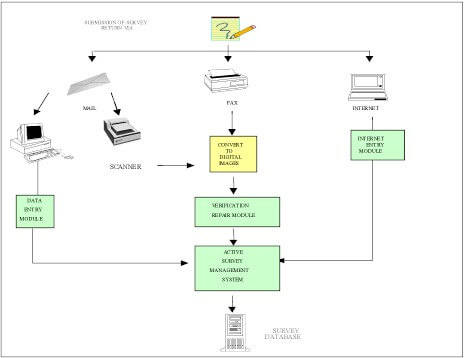Statistical Concepts, Methods and IT Applications
Survey Answering Guide Expert (SAGE) System
Background
In July 1997, the Singapore Department of Statistics (DOS) embarked on the development of the Survey Answering Guide Expert (SAGE) System. The SAGE System is a generic tool for creating survey systems that is able to integrate various survey processes.
It was successfully developed within 18 man-months.
The Sage System
The SAGE System is a joint R&D collaboration between Singapore Department of Statistics, Kent Ridge Digital Labs (KRDL) and Knowledge Engineering Pte Ltd (KEPL). While the current survey processes require intense human involvement, the SAGE System
adopts a re-engineering perspective on how a survey is prepared and conducted. The SAGE System utilises intelligence systems technology, form processing technology and Intelligent Character Recognition (ICR) technology in the system design. The SAGE
is a sophisticated software tool which allows end users to design, create and maintain survey systems. It operates in a Windows-based environment with user friendly Graphical User-Interfaces. The SAGE System supports multiple modes of data collection
via mail (paper), fax and Internet.
In the second stage, records that are not coded automatically are sent for Intelligent coding. ACE retrieves each record and uses AI to suggest possible codes. The AI uses in-built logic such as synonymous words and past relational data between education,
occupation, income and industry to recommend a list of possible codes. Human coders make the final judgement and select the correct code. The panel above illustrates how a record gets coded in 3 simple steps.
Technical Features and Benefits
User driven system setup
One of the core components of the SAGE System is the Smart Form Designer (SFD). The SFD is an intelligent form design tool as well as a database script generator. The SFD supports the rapid design of ICR-enabled survey forms with embedded validation knowledge
that can be distributed by the various delivery modes defined by the SAGE System.
At the start of a new survey, the SFD is used to design the paper questionnaire. Based on the questionnaire prototype, the SFD would then generate the survey database, data entry interface, internet form and integrate with the built-in SAGE survey control
system for survey monitoring. Users only need to specify the relevant parameters and validation rules. The SAGE System would then handle the rest, thereby eradicating the need for specialised computer programming.
Multiple Modes of Survey Submission
The SAGE System is designed to offer multiple modes of survey submission. Respondents can choose to submit their survey returns through mail, fax or internet. The internet submission mode provides respondents a convenient, fast and easy alternative to
conventional mail submission. With secured encryption protocol, the internet submission module ensures that the information transmitted through the net is protected.
The online submission system was first introduced in the 1998 annual surveys. It was offered under the E-survey service launched in August last year. With the introduction of internet submission, respondents can do away with the tedious paper work and
manual tasks of mailing or faxing their survey returns to the Department. The submission can be done 24 hours a day. It also provides an alternative option for survey submission.
The following diagram shows how the various submission modes are handled in the SAGE System.
Flow Chart: Multiple-mode of Survey Submission & Data Processing

Automation of Data Capturing
The SAGE System is equipped with multiple modes of processing capability. Users can choose to process the survey forms using different modules offered by the system.
Returns received via mail can be processed using the conventional data entry module or scanned for ICR processing. The ICR technology is employed to automatically recognise the analogue contents of scanned forms thereby reducing the need to perform manual
data entry. During the process of capturing, the system also allows the verification and repair of the recognised results. The data processing is handled by another SAGE component called the Verification Repair Module (VRM).
Returns received via fax are automatically converted into digital images for ICR processing. Similarly, the data processing part would also be handled by the VRM. Returns received via internet are stored in digital format and captured directly into the
database. With the various modes of data capturing capability, the SAGE System is able to reduce the turnaround time for survey processing and improve productivity.
Online Data Validation
The internet forms designed using SAGE can be embedded with intelligent helps and validation checks to assist respondents in completing their survey forms. Upon the detection of inconsistent or doubtful entries, respondents would be prompted with the
relevant help messages to assist them to correct the errors immediately.
By reducing submission errors, the SAGE system reduces the inconvenience of verification with respondents at a later date. Survey returns can be processed within a shorter time. This helps to improve timeliness and the overall quality of data collected.
Deployment of SAGE
The SAGE System was first deployed in the Annual Surveys of Commerce and Services 1998, launched in August 1999. The surveys covered about 16,000 companies and businesses. The DOS-SAGE team, comprising an Assistant Director (Project Manager), 2 Statistical
Officers and 2 Corporate Support Officers, was intensively involved in the development of the SAGE System, beginning from the requirements gathering to testing and deployment of all the modules.
Future Plan
The successful development and deployment of the SAGE System represents a significant milestone achieved by the Department in the area of data collection and data processing. The implementation of SAGE saw many benefits, most notably significant reductions
in costs and time required to prepare for a new survey. The introduction of the E-survey service has also helped to improve the overall standard of statistical service of the Department. Following the successful launch of the SAGE System on the Annual
Surveys of Commerce and Services, the Business Statistics Division is now working on plans to implement SAGE in other surveys in the near future.
Source : Statistics Singapore Newsletter, January 2000